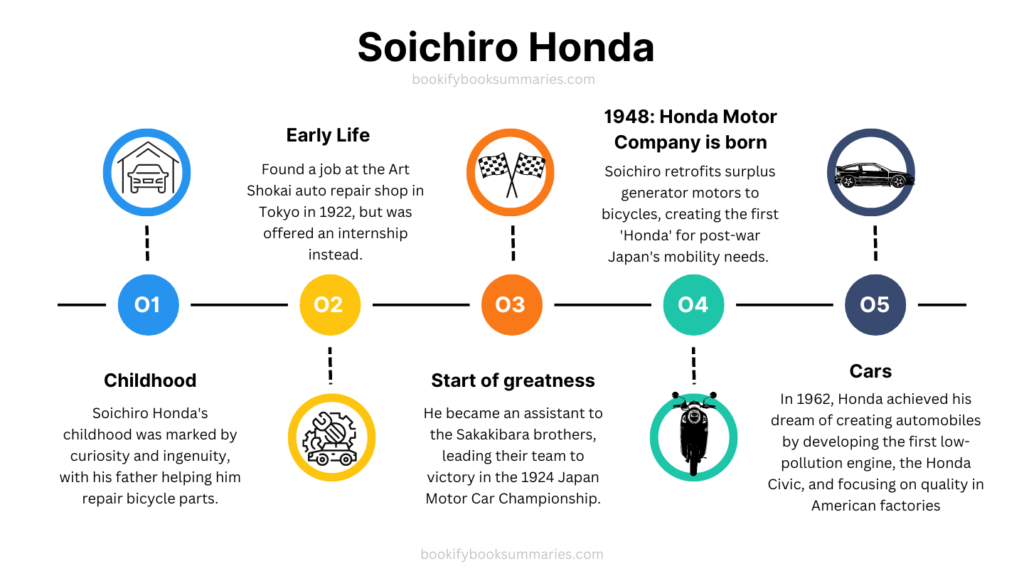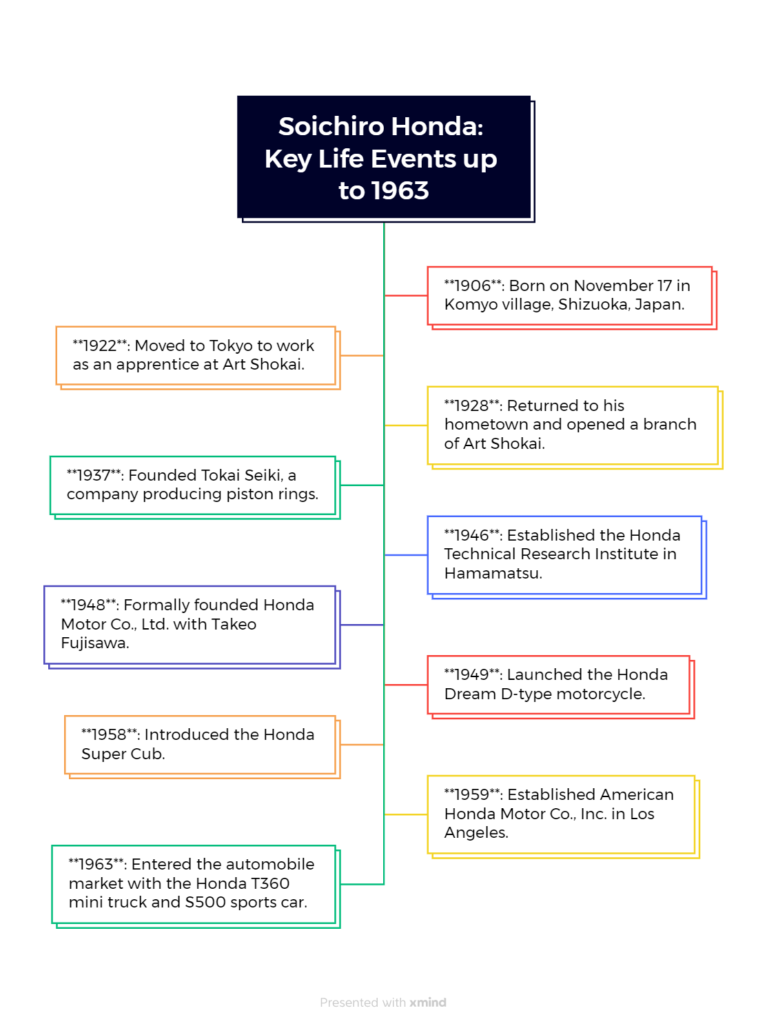
Soichiro Honda, the visionary founder of Honda Motor Company, was born on November 17, 1906, in Hamamatsu, Shizuoka, Japan. From a young age, Honda was surrounded by the sounds of machinery and the scent of grease and oil. His mother, Mika, was a talented weaver who designed her own loom, and his father, Gihei, was a blacksmith who also ran a bicycle repair business. This environment laid the foundation for Honda’s lifelong passion for mechanics.
Childhood Curiosity and Ingenious Tricks
As a child, Soichiro’s favorite toys were bicycle parts, and he spent countless hours helping his father repair bikes. He was always covered in soot from the smithy, but his ingenious mind was already at work. In school, he found a clever way to avoid disappointing his parents over grades. He crafted a family seal from an old tire to stamp his grade reports. This stunt, however, backfired when his teacher noticed the improperly mirrored hieroglyphs. His father’s punishment wasn’t for the forgery itself but for his failure to notice the error—a lesson in attention to detail that Honda carried throughout his life.
Early Work and First Ventures
In 1922, after eight years of schooling, Soichiro found a job ad for an assistant at the Art Shokai auto repair shop in Tokyo. He immediately set off for the Tokyo.
However, he was very young and didn’t secure the job he had hoped for. Instead, he was offered an internship. This offer wasn’t ideal, but he refused to give up. Soichiro didn’t return to his village; he understood that even as an intern, he could learn valuable skills.
Being an intern was tough. He wasn’t paid for his work and was often tasked with menial jobs. Despite these challenges, Soichiro Honda never let his spirit waver. He focused intensely on learning and honing his skills in motor mechanics. His determination was fueled by a burning desire to excel. Every small task he was given, he approached with enthusiasm, seeing it as a chance to grow. Soichiro’s unwavering dedication and passion for improvement laid the foundation for his future success.
His efforts paid off when he became an assistant to the Sakakibara brothers, owners of Art Shokai. Honda helped design a Curtiss race car and served as a riding mechanic, leading their team to victory in the 1924 Japan Motor Car Championship. This success spurred the growth of Art Shokai, and by the age of 21, Honda was managing a branch in Hamamatsu.
Innovations and Setbacks
Honda’s innovative spirit led him to replace wooden spokes with metal ones, earning him a patent and making Art Shokai prosperous. However, his ambition to produce piston rings faced numerous challenges. Despite investing heavily and even pawning his wife’s jewelry, he failed initially. This setback drove him to pursue formal education in foundry techniques, marking a significant shift in his attitude towards learning.
The Birth of Honda A-Type
In 1936, Honda nearly lost his life in a high-speed rally accident. While recovering, he faced another blow: only three of the 30,000 piston rings he had produced passed quality control at Toyota. Undeterred, Honda founded Tokai Seiki in 1937, which flourished during the war by supplying parts to Toyota and other manufacturers. However, the post-war period saw his factory destroyed, and Honda sold his business to Toyota, taking a brief hiatus.
From Mopeds to Motorcycles
In 1946, Soichiro Honda founded the Honda Technology Research Institute and began producing mopeds. His first successful model, the A-Type, laid the groundwork for Honda Motor Company, established in 1948. By 1949, the Dream D-Type motorcycle was launched, quickly followed by the Super Cub in 1958, which revolutionized the market and established Honda as a leading motorcycle manufacturer globally.
Expanding into Automobiles
Honda’s dream of creating automobiles materialized in 1962, despite skepticism from Japanese officials. His commitment to reducing exhaust emissions led to the development of the first low-pollution engine, featured in the 1975 Honda Civic. This innovation, along with his insistence on quality, even in American factories, solidified Honda’s reputation. The Honda Accord, manufactured in Ohio, became a top-seller in the U.S.
Revolutionary Management and Legacy
Honda’s unconventional management style emphasized employee participation, innovation, and non-hierarchical structures. He believed in setting high goals and learning from failures, fostering an environment where creativity thrived. His insistence on not passing leadership to relatives ensured that qualified professionals guided the company.
By the 1980s, Honda Motor Co., Inc. had become the third-largest car manufacturer in Japan and the world. Honda’s empirical approach, willingness to take risks, and disregard for tradition transformed the company into an industry leader. His legacy is evident in the continued success and innovation at Honda Motor Co., Inc.
Retirement and Continued Influence
Soichiro Honda retired in 1973 but remained active, contributing to various organizations and founding NGOs focused on traffic safety and environmental technology. He passed away on August 5, 1991, leaving behind a legacy of 470 inventions and 150 patents. His philosophy—that success is built on repeated failures and perseverance—continues to inspire entrepreneurs and innovators worldwide.
Soichiro Honda’s life story is a testament to the power of resilience, innovation, and the relentless pursuit of one’s dreams. His journey from a small-town blacksmith’s son to the founder of a global automotive giant is a beacon of inspiration for all aspiring inventors and business leaders.

